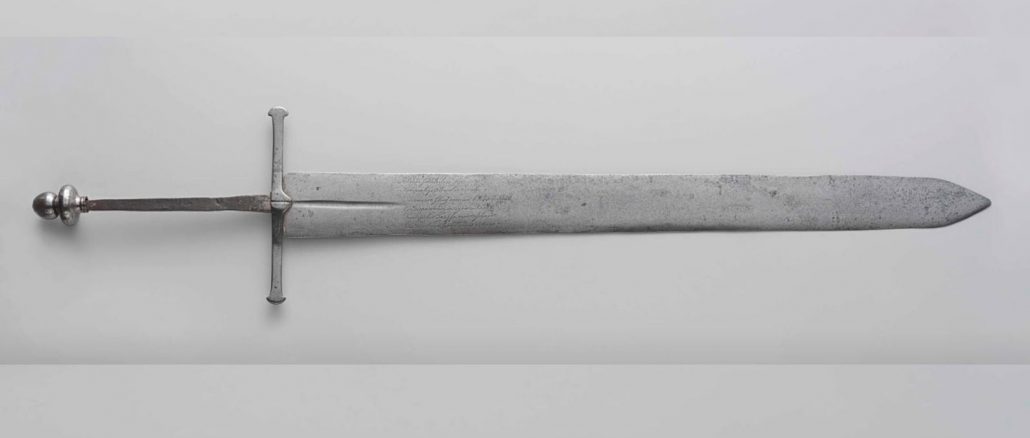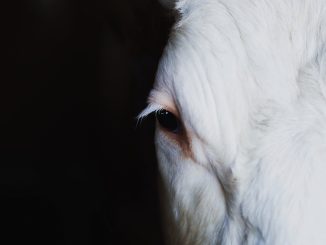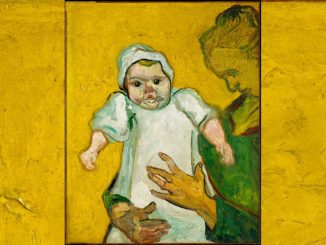
The Rijksmuseum is busy, even though it’s November and far from tourist season. Chattering students herded into ragged lines waiting to enter more than make up for the missing tourists in noise and energy, if not in numbers. We—me, my wife Ellen, and our friend Sharon—surf through the teenage energy and hormones and into the museum. Amsterdam is the last stop of a trip that’s taken us to London and Bruges; today’s goal is exploring the Rijksmuseum, the Netherlands’ national museum.
We make our way to the Gallery of Honor, devoted to the seventeenth century when Dutch art ruled the world. Alcoves along the sides of the gallery display paintings by Vermeer, Steen, Hals, and others; we split up so we can each browse at our own pace and tastes.
I work my way through the alcoves, stopping to examine the paintings that grab my eye. I want to see the Vermeers, as does the rest of the crowd. Each Vermeer is surrounded by a scrum made up of those trying to take selfies with the paintings, those trying to actually examine the small details, and students looking for the answers to the quiz about the museum they are all working on.
I thread my way through the crowds toward Rembrandt’s Night Watch, occupying the far wall of the Gallery. It’s the opposite of the Vermeers—large, bold, dramatically lit, filled with people. It also attracts a crowd, looking at the painting and resting on the benches in front of it.
The crowds disappear when I head off into the smaller side rooms and away from the must-sees. These rooms feel like the Rijksmuseum’s attic; furniture, dishes, glassware, ship models, clothes, weapons, armor. I don’t slow down for the furniture and china, but Room 2.5 has maps on the walls and models of cities. My career was in mapping and historical maps and mapping are interests of mine. I’ve already talked the others into seeing the oldest known elevation benchmark in Europe, established to ensure that dikes were built at the correct elevation. I suspect they are glad to let me go on my own.
One of the room’s display cases holds two walking sticks. Its label catches my attention:
The elderly statesman Johan van Oldenbarnevelt was supposed to have used one of these walking sticks to support himself as he climbed the scaffold on 13 May 1619 to be beheaded. He had been condemned to death after a political trial. In the previous twenty years, he had been one of the driving forces in the young Dutch Republic. The sticks were preserved as relics. In 1657 Vondel wrote a moving poem about one of them.
One of them? They don’t know which one?
An adjacent display case had a sword and another interesting label:
Executioner’s sword used to behead Oldenbarnevelt
While this is certainly an executioner’s sword, it is highly doubtful whether it was used to behead Johan van Oldenbarnevelt. The provenance of this murderous weapon goes back no further than the 18th century. It was in the possession of the poet Frans Greenwood around 1745. He probably had his own verse engraved on it, dedicated to ‘the innocent hero, poor wretched Oldenbarnevelt’.
Johan van Oldenbarnevelt was a major political leader in the Dutch war of independence against Spain and in the formation of the Dutch Republic. In 1586 he became Land’s Advocate of Holland, the most powerful position in the Republic. Ongoing disputes between Holland, the wealthiest state in the Republic, and the other states over trade, foreign policy, and religion finally resulted in Oldenbarnevelt being arrested in August 1618. After a nine-month political trial in which he was not allowed to consult documents in his defense, twenty-four commissioners appointed instead of judges declared him guilty of unspecified charges. The seventy-one-year-old Oldenbarnevelt was beheaded in The Hague on May 13, 1619.
His devoted servant, Jan Francken, stayed with him during his imprisonment and remained by his side at his beheading. In his diary Francken described how the elderly Oldenbarnevelt, leaning on his walking stick, slowly climbed the steps to the scaffold. Joost van den Vondel, the leading Dutch poet and dramatist of the time, used this as the central image in his poem “Het Stockske van Johan van Oldenbarnevelt: Vader des Vaderlands (The Cane of Johan van Oldenbarnevelt: Father of the Fatherland)”:
…
Preserved be thou from time’s decay,
Thou staff of him who, no foul traitor,
But Holland’s father, liberator,
The scaffold climbed on that cruel day;
…
Vondel’s poem, published almost forty years after the execution, established the walking stick as a symbol of the injustice done to Oldenbarnevelt. Other writers and politicians then also invoked the walking stick, once it was politically safe to do so, and made it part of Dutch history.
The most evocative relics recall a person’s story and symbolize their attributes; the walking stick, intimately identified with Oldenbarnevelt and its iconic role in the story of his beheading, touches us more powerfully than the sword. Even if the sword were authentic, it had only a brief, although admittedly significant, interaction with Oldenbarnevelt. Amateur poet Frans Greenwood owned the displayed sword and attempted to turn it into another relic like the walking stick and to turn himself into another Vondel, a century after Vondel’s poem was published. After engraving part of his poem about the sword on the blade, he solicited poems about the sword from his fellow amateur poets by circulating a notebook for their contributions. That notebook, or at least a notebook said to be the actual notebook, is now displayed alongside the sword. Greenwood’s project ended in failure; some of the poets plagiarized their offerings, some wrote poems saying that Oldenbarnevelt deserved execution, while others who had contributed insisted that their work be removed from the notebook when they saw the quality of the other pieces.
We expect museums to be authoritative and to display only verified historical artifacts, but I believe the curators made an interesting choice, or non-choice, in this case. They could have displayed one of the walking sticks, put the other one in a closet, then said that the displayed stick is “possibly” the walking stick used at the execution. I would then have gone on my way happy that I had seen “the” walking stick. Instead, the curators turned their problem into my problem—now have to think about the authenticity of the sticks and whether it makes any difference. The scene evoked by the walking stick interested me in Oldenbarnevelt’s story, but the ambiguity of the relics drew me in further. Does it matter, in any historical, forensic, or personal sense, which of the two displayed sticks, or even some other lost stick, was the one that aided Oldenbarnevelt up the steps? Not to me. The story is the same, the execution scene is the same, no matter which stick was used.
History is a shared story and, like all stories, is a selective recollection, interpretation and retelling of events. There are many possible histories, like there are many possible stories; the historical events and personages that are best remembered have intrinsic significance but also have good stories attached. A historical relic provides a concrete reminder of events, a prop for a memory play. Like a prop in a play, it does not have to be real but must seem authentic from our theater seat or from 400 years later.
***
We visited Bruges before going on to Amsterdam; one of Bruges’s main attractions is the Relic of the Precious Blood, a vial containing a cloth allegedly stained with Jesus’s blood. It is displayed every afternoon at 2 p.m. in the Basilica of the Holy Blood, which we entered but did not stay for the display. The relic is taken on a procession through the city once a year, with an iPhone app available to track its progress.
I first become acquainted with religious relics on earlier trips to Europe. I’m not Catholic and the church I was raised in does not keep bits of dead people around, so there was a bit of morbid fascination for me in seeing ornate reliquaries holding fingers, skulls, and the occasional incorruptible body.
The Catholic Church has a complicated relationship with relics. There are no authoritative biblical teachings concerning relics; instead, the rules and customs concerning their authentication, transfer, and function have evolved over the years. Recognizing that the evocative power of a relic depends upon its relationship to the person it represents, the Church defines a hierarchy of relics: First-class relics are pieces of a saint’s remains, second-class relics are objects touched or used by a saint, such as clothing, while third-class relics are objects that have touched a first- or second-class relic.
Relics in the Church are intended to be foci for meditation and veneration, not objects of worship in themselves. However, the identification of the relic as a physical connection to a saint and the pomp and mystery typically surrounding its display in elaborate reliquaries emphasize its physical reality and may overwhelm the spiritual considerations.
Relics became investments during the Middle Ages, since the presence of a famous relic in a church attracted pilgrims and their money. The cathedral of Chartres had the Sancta Camisia, the tunic worn by the Virgin Mary when she gave birth to Christ. One of the main products of the linen industry in Chartres was souvenir replicas of the tunic for pilgrims to take home. Many relics were miraculously discovered during the late Middle Ages and became part of the relic trade. Crusaders and pilgrims to the Holy Land somehow unambiguously distinguished sacred pieces of wood, cloth, or bone from other identical pieces of wood, cloth, or bone. Vials of Jesus’s blood and the Virgin Mary’s tears or milk that had been captured and preserved over hundreds of years were found. Miracles were invoked to explain discoveries of relics from the Holy Land in more convenient parts of Europe; after St. James was martyred in Judea, his body was said to have been brought to Spain on a rudderless stone ship. Multiple copies of particularly valuable relics appeared, such as skulls of John the Baptist.
Once a relic has been accepted by a church official and given a certificate of authenticity, its provenance is not questioned. The Church usually takes no official position on older relics of questionable authenticity such as the Virgin Mary’s house that flew to Loreto, Italy, after stopping at two places along the way, or in the case of competing relics like the multiple skulls of John the Baptist. A rare exception was the Holy Prepuce (Jesus’s foreskin), several of which were discovered during the Middle Ages. One was allegedly worn by St. Catherine of Siena as a ring. The most famous prepuce was found in the town of Calcata, Italy, in 1557, but after another one was rediscovered in France in 1900, the Vatican decreed ex-communication for anyone who wrote about the Holy Prepuce or spoke its name. The relic was still displayed in Calcata on the Day of the Holy Circumcision until 1983, when it mysteriously disappeared from a shoebox in the local priest’s closet.
Some older reliquaries have been reopened and found to contain additional pieces of bone, cloth, sticks, stones, or bags of dirt along with the original relic. These typically appear to have been added to the reliquary after its initial construction and often have illegible or missing labels, making identification impossible. An unknown relic would seem to be worthless, since there is no specific saint to venerate or story to meditate upon. However, the assumption is that since it has been treated as a relic of a saint, although one who is now known only to God, it must have been a known relic at some time. It should therefore be venerated in an appropriate manner.
Healing performed through relics further confuses the distinction between their physical and spiritual aspects. The Church stresses that the miracle is performed by God through the intervention of the saint, and that the relic is only a symbol. However, healing nearly always involves seeing or touching the relic, as if the power does reside in the physical object. If only the spiritual aspects of the relic are important it shouldn’t have to be present.
Faith healing, or healing through relics, is usually explained by the placebo effect, where the mind is fooled into healing the body. The patient must believe that the placebo is real. in traditional medicine this means that the placebo’s appearance and the procedures used must be what the patient would expect with an actual treatment. The patient must believe in the relic’s power. If a pilgrimage is required, the patient/pilgrim will be even more invested in the relic’s power.
The authenticity of most relics is unknowable in any objective way—there’s no way to prove that a bone came from a certain saint and usually no way to prove that it didn’t—but this is irrelevant. The object within the reliquary is unimportant; it’s the shared belief in the story it evokes that gives a relic its power to inspire or heal.
***
One of my earliest encounters with religious relics was a trip to Italy with my wife in the spring of 1989. We were in Florence and having already seen many churches, many with relics, we both needed to spend an afternoon not seeing churches. In a pattern that has been repeated often in our travels, she went shopping and I visited the Institute and Museum of the History of Science.
It was a warm afternoon and the windows were open in hopes of a breeze off the Arno. The museum was mostly empty and the guards, all middle-aged Italian women, were gathered in one room engrossed in their conversations and barely noticed me.
I entered a gallery filled with globes, astronomical instruments, and a display case containing what appeared to be two reliquaries, somewhat unexpected in a science museum. The first held a cracked objective (front) lens from one of Galileo’s telescopes, mounted in an ebony and ivory frame. The lens was smaller than most kid’s telescopes today, only about 38mm in diameter, and incongruously unimpressive given what Galileo discovered with this lens. The second reliquary was a white marble column with an inscription on the front and a crystal globe on top that, if I was translating the label correctly, contained the middle finger from Galileo’s right hand. Since one seldom sees the body parts of dead scientists in science museums—bones of early African hominids maybe, but not the bones of scientists—I had to have a photo. Just as I was focusing one of the guards came by to check on me. “No pictures! No pictures!” she yelled, waving her hands to make it clear. Satisfied that she had prevented my photographic desecration of the relic, she went back to her conversation and I took photos at my leisure.
Galileo became famous for his discoveries in the fields of astronomy, physics, and optics. His development of a better telescope enabled his discovery of the moons of Jupiter, the rings of Saturn, the phases of Venus, and sunspots, and he showed that falling objects accelerate at the same rate, no matter their weight. His scientific methods combined experimental observations with mathematical analysis. His assistant Vincenzo Viviani devoted much of his life to the documentation and preservation of Galileo’s work and even put a bust of Galileo and commemorative inscriptions on the façade of his house.
Galileo’s defense of the heliocentric model of the solar system brought him into conflict with the Catholic Church, which interpreted scripture as saying that the Earth remained fixed with the Sun and planets rotating around it. In Copernicus’ heliocentric model, the Earth rotated around the Sun. Galileo’s observations of Jupiter’s moons and Venus’s phases supported the heliocentric model.
Italy’s clashes between religion, science, and politics in the 17th century helped make Galileo a political symbol after his death. He was originally to have been buried in a place of honor in the nave of Florence’s Basilica of Santa Croce, but Pope Urban VIII, who had had him arrested and tried for his astronomical publications, objected to having a monument in the Basilica to someone condemned for “vehement suspicion of heresy.” He was instead buried in a small room outside the Basilica itself. In 1737, almost a hundred years after his death and after new ecclesiastical leaders had come into power, Galileo’s body was moved to a marble sarcophagus in the nave of the Basilica which had been funded by a bequest in his assistant Vincenzo Viviani’s will. The re-burial was supported by the ruler of Tuscany as a symbol of the state’s independence of the Church.
When the body was moved to its new sarcophagus the middle finger was removed by Anton Francesco Goti, founder of a society for the promotion of the arts and sciences in Florence and “almost all the most distinguished and useful parts of human knowledge.” Placing the finger in a reliquary can be seen as inspired by the veneration of religious saints; the Museo Galileo says that the reliquary displaying his finger “exemplifies the celebration of Galileo as a hero and martyr of science.” The inscription reads in part, “This is the finger, belonging to the illustrious hand/ that ran through the skies,/ pointing at the immense spaces, and singling out new stars …”
Is displaying wizened body parts the correct way to honor a scientific “saint”? To me, the second-class relics of Galileo, his telescopes and notebooks, are far more evocative than the first-class relic of his finger. Yes, he needed fingers to build telescopes and write in his notebook, but when I think about his work I don’t think of his fingers. Instead, I think of what he discovered—the moons of Jupiter, Saturn’s rings—with his telescope, no more powerful than a kid’s telescope of today. I think of his scientific mind, creative and confident enough to accept the evidence of his observations. In this case there’s little doubt as to the authenticity of the relic, but it’s nothing more than a curiosity, irrelevant to the greater story of Galileo and his science.
***
My father and I were sitting and talking on the back porch at home one evening, probably fifteen years ago or so, and he asked if I remembered his father. He had asked this several times before; he was in his late 70s, beginning his decline into dementia, and seemed to be trying to hold on to the story of his life.
The only clear memory I have of my grandfather, Russell McGlone, is of being taken to see him when I was five or six years old, which I now realize was when he was on his deathbed. I described this memory to Dad, again—entering my grandparents’ small house, turning left into the hallway, then right to go into the bedroom, and seeing him there in his bed. I believe he spoke to me, maybe even patted my head. The obvious importance of the occasion made an impression on me, even though I did not understand what it meant at the time.
Dad thought for a minute, then reached into his pocket and pulled out a pocketknife. He handed the knife to me, saying that it was his father’s and he wanted me to have it. I’m the oldest son, as was he. I thanked him and examined it, unsure of what else to say at this important, unexpected moment. Dad and I had that same conversation about his father several more times before that part of his memory was completely lost. Dad died in 2008.
It wasn’t a collector’s knife, it was a farmer’s knife, and looking at it was like looking at a photograph of my grandfather. The handle was polished from use and the small metal shield with the maker’s name was worn smooth. A thousand trips across the whetstone had left the blades thin and their edges curved, testifying to the number of times it was used to cut baler twine, whittle a wooden peg, or the other tasks that make a pocketknife a necessity on a farm. I could hear the rasp of the knife against the whetstone and the pause between strokes while he tested the edge with his thumb. I could see him showing my father how the knife would shave the hair from his arm. I could see the knife left on top of his dresser in the evening, or maybe just left in the pocket of his overalls hanging on a chair, ready for the next day.
I put the knife in the old “Yaller Dog” cigar box where I keep mementos like arrowheads and old coins and didn’t think about it for a while. Not long ago I was looking in the box for something else, came across the knife, and decided to try cleaning it up some. While looking at some knife collector websites to find out the best way to clean it I noticed that they also had information on identifying and dating pocketknives. The base, or tang, of the main blade is stamped:
SCHRADE
N.Y. U.S.A.
80T
This identifies the knife as a Schrade Old Timer, made between 1973-2004. I checked the date of my grandfather’s death again: 1958.
Did I just misunderstand what Dad said about the knife? He could have been confused about whether it was his father’s knife or his own. Could it have been my own wishful thinking, a desire for some concrete memento as I saw my father slipping away?
I can imagine my father with the knife—he certainly carried it, used it, sharpened it—but somehow the image that it calls up is of my grandfather. The knife is a physical symbol that evokes my second-hand memories of him; even if it wasn’t my grandfather’s, it’s the only thing I have that’s even remotely connected to him. It’s a not-quite-blank slate onto which I can project my ideas of his life.
Even though I don’t have any personal memories of my grandfather, I’ve heard many stories about him. They tell me he was short, like my father, strong and wiry, and always wore bib overalls. He was tough, the kind of tough you get working a rocky hillside farm on the head of Grassy Creek in eastern Kentucky.
He was in town once and got into an argument with a younger man about where his wagon was parked. The younger man finally said, “If you weren’t so old I’d yank you down off that wagon and give you a whipping.” Grandpa McGlone just looked back at him and said, “Son, don’t let a few gray hairs make a coward out of you.” That ended the argument.
The knife reminds me of how different his life was than mine, and of where I’m from. Although I worked on a farm when I was young, I’m not a farmer. Instead of a real pocketknife, I carry a small Leatherman tool on my keychain. The knife is on my desk next to two computers in an office filled with papers, books, pictures, and CDs. His work was always physical, hot, sweaty, and dirty. My work has always been abstract; scribbled math, computer code, digital images, words on a screen.
The knife reminds me of how tenuous my connection to my grandfather is. I remember my grandmother Erie McGlone, a square, solid woman, black hair streaked with gray pulled back in a bun. I remember her father, Grandpa Messer, who came to live with her and spent his days in his rocking chair spitting tobacco juice into a coffee can. I remember the farm, the barn with the hayloft we played in, the rooster that flogged me. I remember the sycamore trees in the front yard of the house with their white-washed trunks. I remember the family reunions under those trees when all twelve of Grandma’s children came with all of their children, my cousins, and grandma McGlone stood on the porch looking at her family assembled in the yard. I can remember all this, but I don’t remember him. All I have is the knife.
AUTHOR

Chris McGlone
Chris McGlone is currently an MFA student in creative nonfiction at George Mason University. In his previous life as a photogrammetrist he published a number of technical papers and book chapters and co-authored a textbook. Other interests include playing Irish guitar and bluegrass banjo.
Twitter: @chrismcglone75
Featured image: Anonymous, “Executioner’s sword used to behead Oldenbarnevelt,” iron (metal) forging, 1600 – 1625. Rijksmuseum.


